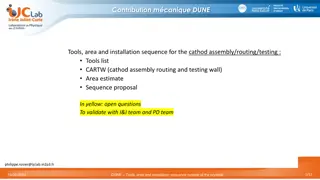Understanding Cathode Failure in Pot Operations
Exploring the impact of cathode components on pot life in manufacturing, relining, and operation processes. Observing symptoms of rat hole failures and investigating possible root causes to suggest improvements for better control of operations and prevention of failures.
Download Presentation

Please find below an Image/Link to download the presentation.
The content on the website is provided AS IS for your information and personal use only. It may not be sold, licensed, or shared on other websites without obtaining consent from the author. Download presentation by click this link. If you encounter any issues during the download, it is possible that the publisher has removed the file from their server.
E N D
Presentation Transcript
Cathode Components that Impact Pot-life Raw Materials Manufacturing Cathode Blocks Pot Design Cathode Relining Pot Preheat & Startup Pot Operation
Cathode Failure Observations Cathode Failure Observations - - Turkey Smelter Turkey Smelter Cathode Problems: Occur in the same potroom. Occur in the same up-stream location in pots. Occur in different cathode blocks; same block producer (NDK). Almost never occur near the ends of pots. All rat holes were located at a vertical cracks. Pot Operations: Heavy muck in pots due to alumina fines. To decrease muck - increased bath temperature by decreasing the %AlF3. Highly unstable pot operations.
Initial Thoughts Rat Hole in Cathode Block Vertical cracks came first prior to Rat holes. Vertical cracks are due to the upward bending of cathode blocks.
Symptoms of Rat Hole Failures Symptoms of Rat Hole Failures Rapid increase in iron content is due to the delamination of cathode blocks & the steel collector bars start to fail. Rapid increase of %Fe (exposure of collector bars to metal).
Possible Root Causes: Possible Root Causes: Seems not particularly investigated in autopsies, but probably upwards bending of bottom blocks due to vertical and uneven expansion of barrier layer. Appeared fairly early in life (many thin cracks, slower expansion tends to produce fewer and larger cracks). All cracks infiltrated with aluminium, but most rapidly sealed by Al- carbide formation. Cracks with Al metal for prolonged time can result in pot rat hole formation.
Improvements Improvements Better control of operations, (avoid excessive bottom ledge formation, and avoid thermal transients). Temperatures 930-990C reported, that caused bottom panel to expand and shrink several mm transversely and much greater than >1cm longitudinally, possibly opening infiltration cracks. Monitor ramming installation closely. This is the most critical phase in the relining operations. Not enough information to decide if modification of rammed joints will improve sealing. Firebrick is more stable than the (powder) barrier mix.























